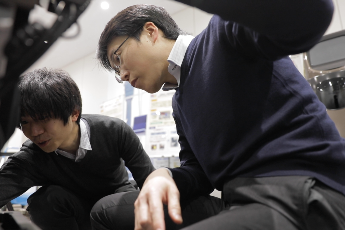

(Developers)
Panasonic Corporation, Life Solutions Company, AGE-FREE BU, Robot and Rehabilitation Bussiness Development Department, Manager Yohei Kume
Panasonic Corporation, Life Solutions Company, AGE-FREE BU Robot and Rehabilitation Bussiness Development, Assistant Chief Shohei Tsukada
(Co-creator partners)
Panasonic AGE-FREE Co., Ltd, Life Support Business Division, Manager Hitoshi Sasaki
*Date filmed: 3/7/2019
The Field Requires Nursing Devices that Can Actually be Used
Kume has been working on developing nursing robots since 2006 when he moved to the R&D Division’s Robot Development Office via the internal job posting system. While finding out what people in need of nursing care needed, he says he decided to focus on the process of moving from the bed to the wheelchair (transferring), a task that demands a great deal both mentally and physically, and began to develop nursing robots.

What the field requires is not a so-called nursing robot, but rather a nursing device that will actually help on site. As such, daily research and development is being conducted into how to apply robotics to create nursing devices.
Transfer Assistance Robots
A transfer assistance robot was the first to be developed. The robot performs the task of lifting someone up as a human would in a bridal carry-like fashion. However, there were three essential problems with this transfer assistance robot. The first is that as someone is being lifted up, there is always a risk that they may fall. Secondly is the issue of space. In the relatively small space that is a nursing living area, setting up another device in addition to the existing beds and wheelchairs would prove quite challenging from a space perspective. Lastly, is the issue of peace of mind with regard to operations. Beds and wheelchairs are items we are used to seeing, but new nursing robots may cause a sense of unease with regard to operating them and those receiving care may also feel unease using a nursing robot they see for the first time. Eventually, they came to the conclusion that continuing with the original image for a robot that lifts up those in need of care would be too difficult, which lead to a new idea where the bed and wheelchair were combined. This idea, which greatly changed the direction of the project, lead to the birth of Resyone.
The Birth of Resyone
Tsukada works together with Kume in the development of nursing robots, and gave birth to this new style of bed, Resyone, where part of the bed is a detachable wheelchair. He says that the biggest attraction of Resyoneis the fact that it reduces the psychological anxiety and physical burden on the caregiver.

Normally, when moving someone from the bed to a wheelchair, a caregiver would lift them up and move them. With Resyone, you can move said person from a laid down position into a wheelchair, eliminating the need to lift them up. Not only is the pressure on the caregiver’s lower back relieved, but the fear of dropping the patient and the fear of being dropped on the patient’s side is also reduced. It has the same shoulder lifting, leg lifting, and raising features as a normal nursing bed, but can also be changed into a chair when operated as a wheelchair. Realizing the combination of each of these basic features saw the birth of a world first, original design.
Creating Together With Those on Site
“I thought it was amazing” says Sasaki as he reflects on actually using the technology on site, remembering his surprise. He states that the fact a task that used to require two or three caregivers has been simplified to just one is what is revolutionary about the technology.

In order to observe how workers actually work on site, the developers worked the night shift together with them and carefully listened to what the workers had to say, which allowed them to grasp the issue and lead to the development of Resyone. The ideas and feelings of those on site are not done justice with words alone. What was important was actually seeing the situation with one’s own eyes and listening first-hand. Kume believes that understanding what the nursing staff experience first-hand was the challenge. The process involved actually visiting a site, acquiring information that would provide hints for development, then actually developing nursing devices. These devices were then evaluated on site and improved so they would be useful nursing devices for those at work. These links and cooperation between those on site and the developers were vital in the development of a nursing robot.
This article was created based on the video Resyone, a robot that helps users get out of bed【customer × Panasonic】. Please see here for the video.
